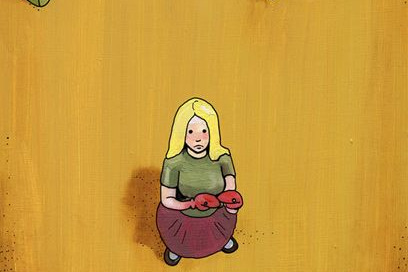Warren Peace Classic: The Deformitory, by Sophia Wiedeman (a.k.a. Sophia Glock)
Sometimes it's good to remember small comics from years ago that you enjoyed.
Here’s a review I published way back in 2009, looking at a short comic by Sophia Wiedeman, who now goes by the name Sophia Glock. I was reminded of her work when I realized that both Sophias were the same person after mentioning her in my recent review of the new issue of So Buttons.
I should note that the Xeric Grant, for those who don’t know about it, was an award given out to alternative comics creators by a foundation established by Peter Laird, one of the creators of the Teenage Mutant Ninja Turtles. Between 1992 and 2012, the Xeric Foundation gave out grants to help creators self-publish comics, and recipients included people like Adrian Tomine, Gene Yang, Anders Nilsen, Sonny Liew, Jeff Lemire, and Blaise Larmee, putting Glock in pretty good company. Unfortunately, it doesn’t look like The Deformity is available anymore, but if you get a chance to seek it out, I recommend it. Glock has been continuing to create comics in the years since, including publishing an autobiography called Passport in 2021.
Also of note: it seems that I tend to interpret stories as being about mental illness, which may or may not say something about me. I did the same thing in my reviews of the TV show Constellation, and I’m sure I’ll continue to see it in other works that seem allegorical. When I met Glock at the Chicago Alternative Comics Expo (CAKE) one year, she thought my interpretation was fascinating, since for her, the story was all about Catholicism. That’s the cool thing about art, isn’t it? Everybody brings their own interpretations, and they can find meaning even in ways that may not have been intended.
The Deformitory
By Sophia Wiedeman
You've got a girl with sentient claws for hands, a mermaid with octopus tentacles instead of a sexy fish tail, a girl that's a slug from the waist down, a girl with a skeleton body, and several other freaks in the building of the title, a sort of retirement home or sanitarium for abnormals like them, although one suspects that this is all symbolic. Sure, that's kind of obvious, but the question remains what the allegorical content stands for, and the beauty of Sophia Wiedeman's work is that one could come up with several possible interpretations.
The main story in this 46-page Xeric Grant-winning pamphlet follows Dolores, the aforementioned claw-handed girl, who develops her condition after what seems to be a typing-induced bit of carpal tunnel syndrome. Surprisingly, the claws don't bother her too much, especially since they have eyes and speak to her, becoming her friends and confidants. Soon she's having a swell time with them, although the people she encounters find the whole thing kind of gross. The problems start when her claw-hands develop their own independent thought, and start disagreeing with her choices, even becoming violent. She's forced to take drastic action, and while it solves the problem, she ends up losing something that seems precious.
So what's the interpretation here? It seems to me that it's about mental illness, perhaps bipolar disorder. The claw-hands enrich Dolores' life, making her feel like she's got friends and is happy, even though she's separated from the rest of humanity. It feels good, but at some point, it becomes too much to handle, and she gets hurt even worse. She ends up doing something terrible, just as people end up hurting themselves when they feel like there's nothing else they can do. And when the problem gets "solved", she misses the euphoria she felt. It's a sad comment on the way mental illness can ravage one's emotions and leave you scarred for life. Or that's one way to see it, at least. Maybe something like addiction could also be mapped onto the story, or other parts of the human experience. The interesting thing is, Wiedeman managed to capture something universal and relatable here; it's impressive work.
Other stories in the booklet do much the same thing; the octopus girl shows the effects of self-esteem issues, with an amusing twist that shows how eager people are to dish out punishment as well as take it. And a boy who spots a unicorn ends up spending his whole life trying to catch another glimpse of the beast, as so often happens when people can't let go of something that they once experienced. I'm not sure what the cartoony "heart monster" means, but it does make for a cute visual, at least.
Wiedeman's art makes for a good way to deliver this type of story; it seems simplistic, with characters having dots for eyes and minimal expressions, but she fills pages with plenty of dense linework and a gorgeous sense of design, especially in the dark forest and the somewhat fantastical Deformitory. She also does some interesting things with scale, making the island on which that building stands look tiny next to the neighboring shore, emphasizing how tiny this place of solace is compared to the rest of the world.
Wiedeman definitely has something here, and hopefully she'll be able to explore this unique sensibility in her further work. That's exactly what the Xeric Grant should be about, letting talented creators get their work out there, and it should be fascinating to see what Wiedeman comes up with next.




